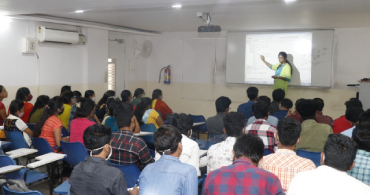

A comprehensive training program with a well-integrated approach to embedded system development. Our training program will impart hands-on experience on a spectrum of embedded applications, thereby making our students industry-ready.

Introduction Overview of Architecture of 8051 Low – Level programming concepts Middle level programming concepts.

I am Madala Badri. I have joined vector through my cousin and it was the best thing done for me by him. Vector has given me so much that I can never pay back. Me having an year gap lost all the hopes but vector made me believe myself. This program played a key role in shaping my career in embedded systems. and finally getting placed in Indian Institute of Technology with 5LPA made my career start and I am glad I joined vector and I am thankful to my staff there and my cousin for suggesting me vector. Overall, I am proud to be a Vector student. The knowledge and confidence I gained here have laid a strong foundation for my career in embedded systems. I highly recommend Vector India to anyone looking to build a career in embedded systems

Hello everyone, I'm Saipavan Maharaju. (V24HE7M2)I completed my B.Tech in Electronics and Communication Engineering (ECE) from Institute of Aeronautical Engineering College, Hyderabad. After graduation, I decided to further specialize in embedded systems and joined Vector India’s comprehensive training program.
The faculty is knowledgeable, supportive, and always ready to guide students. The practical sessions and projects were particularly helpful in bridging the gap between theory and real-world applications.
Vector’s dedicated placement support team ensured that I was well-prepared for interviews, ultimately helping me secure a job in LG Soft as Software Engineer with 4.8LPA.
I want to express my heartfelt thanks to the Staff , placement team and some incredible friends at Vector for their continuous encouragement and support throughout the journey. I highly recommend Vector to anyone aspiring for a career in embedded systems.

I have completed a 6-month Embedded Systems training program at Vector Institute, India, which provided me with a strong foundation in core electronics, Embedded C, RTOS, microcontrollers, and hands-on project experience. The structured curriculum and experienced faculty played a key role in shaping my technical skills.
I’m happy to share that I have been placed in Rapyuta Robotics with 7.2LPA as a part of the placement support provided. I’m grateful to Vector Institute for their excellent training and guidance throughout the journey.
Overall, I had a great experience at Vector India. It’s a solid choice for anyone looking to build a strong foundation and career in embedded systems.

I am Praveen Pula, a graduate in Electronics and Communication Engineering from VRIT (JNTUK). Following my graduation, I successfully completed the Embedded Systems Program at Vector India, Chennai. The training was exceptional, with a strong emphasis on practical application and expert faculty guidance. I appreciate Vector's role in enhancing my technical skills in the embedded domain. During the placement drive, I got a job at IndiNatus India Private Limited with 3lpa. I am filled with joy and gratitude for this achievement. If anyone is truly interested in embedded systems, my best suggestion is to join in vector India. I sincerely thank the entire Vector India team for their continuous support.

I am bindhiya, I joined Vector India, Chennai for the Embedded Systems course, and it was a great learning experience. The faculty are knowledgeable and supportive, explaining concepts clearly and giving plenty of hands-on practice in labs. The curriculum covers C, C++, Embedded C, Linux, and microcontroller programming in depth, which really boosted my confidence. Mock tests and interview preparation sessions helped me a lot during placements. I got placed in a LycaTech Services with 2.75lpa package, and I’m grateful to Vector for guiding throughout the journey.

completed my training at Vector Institute, where I gained in-depth knowledge of various programming languages and technologies such as C, C++, ARM architecture, and more. The hands-on experience and guidance I received there significantly improved my technical skills and problem-solving abilities. This training played a major role in boosting my confidence and ultimately helped me successfully crack the interview at Qmax Systems with 4.2LPA Overall, I had a great experience at Vector India Thanks to all the faculty for their great support and guidance.

Hello everyone, I am Hariprasad , I came to study from Madurai and my relatives told me about the Vector and its placement opportunitie It's a good Institute that gives a lot of opportunities once you are willing to learn.. It's a wonderful experience especially Mr. Badri sir who teaches each and every topic with lot of clear explanations. His classes gives us valuable insight into each and every topic and does makes us understand the concepts a lot deeper. The knowledge and confidence I gained here have laid a strong foundation for my career in embedded systems. I highly recommend Vector India Institute to anyone who is serious about building a career in embedded systems. I got a job in NATRINAI Technologies with 2.5lpa

I did my embedded systems course at Vector India and it was really good. They covered all the important topics like C, C++, Embedded C, microcontrollers (8051, ARM), Linux, RTOS, and communication protocols (UART, I2C, SPI, CAN) in detail. The teaching was clear and practical, with a lot of hands-on labs that helped me understand how things work in real time. The faculty were very supportive and explained concepts well, so even tough topics became easy to follow. Overall, it gave me strong knowledge in embedded systems, which helped me get placed in SRM Technologies with 3.2lpa.

Heartfelt Thanks for Placement Opportunity Dear Vector, I would like to sincerely thank Vector teaching faculties and the Placement Cell for providing me with the opportunity to be placed as an Embedded Developer in "SRM Tech" chennai with 3.2lpa. This achievement would not have been possible without the constant guidance, training, and encouragement I received from the institute.
The knowledge and skills I gained during my course journey, combined with the support from faculty and placement team, have been invaluable in helping me achieve this milestone. I am truly grateful for the confidence the institute has instilled in me, which has enabled me to take this important step in my professional career.
Once again, thank you for your continuous support and for shaping my career path.

Dear Team, I am very grateful to Vector India – Chennai for providing excellent training and placement support. The course structure is practical and industry-oriented, which helped me strengthen my knowledge in embedded systems, C, C++, ARM, and Linux.
The faculty are very supportive and always ready to clear doubts, which gave me the confidence to face interviews. With their guidance, I successfully got placed in SRM Technologies with 3.2lpa.
Thank you, Vector India, for being a strong foundation in my career journey.
Vector India offers both long term and short-term courses.
Course: Embedded Systems
Duration: 6 Months
Admission through Online Scholarship Test
| Automotive Embedded Duration: 72 Hours Direct Admission |
AUTOSAR Duration: 72 Hours Direct Admission |
Micro Python Duration: 2 Weeks Direct Admission |
| Embedded C Duration: 6 Weeks Direct Admission |
Python Duration: 30 Days Direct Admission |
Embedded systems are self-contained programs that are embedded within a piece of hardware. We can say it’s a specialized computer system that is part of a larger system or machine. Typically, an embedded system is housed on a single microprocessor board with the programs stored in ROM. Embedded system can also be defined as a computer system that is created with optimal efficiency, thereby allowing it to complete specific functions as quickly as possible. Embedded systems microprocessors are programmed to automate certain tasks. Cell phones, computers, copiers, medical equipment, programmable logic controllers, and numerous other products rely on embedded systems. Real time embedded systems can be used to replace traditional software applications.
Embedded systems are used in any application or which requires certain level of automation or intelligence. As more and more intelligent devices make their way into our lives, the demand for embedded telecom will increase. In addition, even in areas where telecom companies are in the grips of a slowdown, companies are not making cuts in introducing new features.
The range is really very wide, limited only by human imagination,” B J Ram Rao, CEO, eSmartNet (a division of Zicom Electronic Security Systems) admitted in a recent interview with Zee India. “I would think that, broadly, the embedded system application areas would be wireless, Internet and mobile communications, industrial control, test and measurement, networking, aerospace and automotive control, consumer electronics, digital imaging and defence.”
Embedded System is the future. Every industry needs some artificial intelligence into it and artificial intelligence can be given by embedded systems only. No electronic product is without embedded systems in the market.
The embedded system market is estimated to reach from $86.5 billion in 2020 to $116.2
Billion by 2025, at a CAGR of 6.1% from 2020 to 2025.
According to an IDC report the international market as a whole expects product development worth $75 billion, which will require as many as 5,00,000 trained professionals in embedded systems development by the year 2005. While India is a known player in the software services space, the image of the country has been so far as a low-cost service provider. This is where embedded software development, which requires specialized skill sets, can make the difference. Not surprisingly, companies like Wipro, Sasken, Texas Instruments, L&T, Infosys, Siemens, Honeywell, Motorola, Agilent, Patni etc. are all getting into the race. It is a sector promising a fast-track career, which is only for the brightest and the best.
The global embedded and telecom market today is worth one trillion dollars (Source: Gartner).
The increase in the number of research and development activities related to embedded systems, rise in demand for advanced driver-assistance systems (ADAS) and electromobility solutions for electric vehicles and hybrid vehicles, increase in demand for portable devices such as wearables, and rise in the use of multicore processors in military applications are making embedded systems one of the most sought-after fields in the market.
2020 – 86.5 billion USD 2025 – 116.2 billion USD (Global Embedded systems market growth).
We teach basics and underlying concepts of Embedded Systems in detail, and provide real-time experience to students. This will help each student to not only understand the concept, but also the knowledge of applying concepts in real time situation. Our Embedded Systems & VLSI courses provide complete practical knowledge to students, and makes students ready for placement with Embedded and VLSI industry.
To make the Embedded Systems course full-fledged and complete we have included modules like Object Oriented Concepts with C++, RT-Linux with porting on ARM, 4 mini projects and one major project We cover the Micro controllers in great depth: Intel 8051 and ARM 9 series. In addition, we go for the hardware interfacing in detail. To meet the latest industry requirements, we have included in the course content ARM microcontrollers, Version control tools, and GSM.
Our continuous liaison with Embedded industry has enabled us to know their expectations of each candidate. So, our highly experienced faculties have made sure that our students come out as industry ready professionals.
We have dedicated placement cell to take care of the placements and to make sure that the students are placed at the best possible places. We have ever improved placement record of 630+ campus drives & 2150+ Selects during the year 2021.
The admission into Embedded Systems course is based on our Vector Online Entrance examination. *Working professionals with Relevant Experience are eligible for Direct Admission.
Recent trends show that modern-day users do not want to know how a device works but they just want to utilize it with the shortest learning possible.
26, Nov 2021
The attrition rate of leading firms in India is now at an all-time high and companies are facing issues in executing large projects.
30, Oct 2021
It is quite evident that rapid increase in billions of IoT devices has already created a weak spot in the ecosystem due to lack of security.
3, Sept 2021
COVID-19 left us vulnerable to unprepared dangers that we have never encountered before. Due to its high transmissibility and the lack..
26, May 2021

Aspirants, who are willing to shape their career as an expert in Embedded System and Full Stack Development, can come to our institute and get the benefits of our training courses. We provide best in-class training courses that would reform your concept regarding the subject matter.